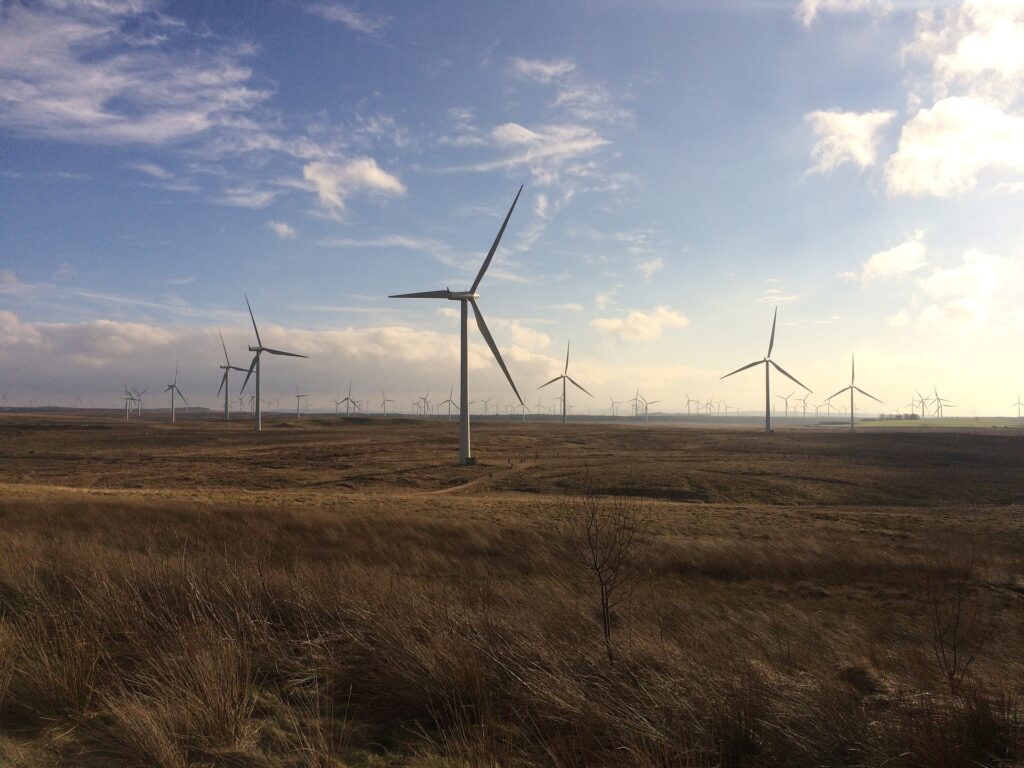Ten years ago powering Scotland by 100% renewable energy was just a hazy ambition, now it’s just a breezy day away from becoming reality.
You can write all the headlines and opinion pieces you like about the industry having ‘missed’ its target, and yes that is all factually correct. But it also churlishly overlooks what astonishing distance has been covered in getting even this far.
More than that, it brings into sharp focus what more must be done to accelerate and enable the industry in a way that delivers meaningful progress.
First the numbers.
Some 97.4% of Scotland’s energy consumption is now met by renewables. That’s from a point in 2011 of 37%.
The 2020 figure quoted above is also an 8% improvement on the previous year, also showing a continued trend.
So you can bet your bottom bitcoin (other currencies are available) that Scotland is likely to be celebrating 100% in time for COP26 taking centre stage in Glasgow.
Pause to think about that for a moment.
The energy consumption of an entire nation capable of being powered by onshore wind, offshore wind, wave and tidal, sewage sludge digestion, solar, anaerobic digestion, hydro, energy from waste, landfill gas, and yes … even controversially biomass.
An entire nation.
Renewable supplies are of course controversial in their own way be it from location to benefits, damage done to economic drivers, from potential to political obfuscation.
What cannot be denied is the incredible technological achievements, the opportunities the sector creates and the tantalising truth of how so much more can follow. Of how many jobs have been created, solutions found, policies written and progress made.
As one target passes us by another looms large. The legally binding commitment of Scotland to hit carbon net zero by 2045.
Does it really matter or is it a number on a page to ensure someone somewhere pays some notice to the fact that it can’t just be shut in a bottom drawer? An official, self set deadlines for a problem in reality is so scarily of the now.
It is still too far away. It just happens to be the best we are currently willing to aim for. Not so much of a compromise as a fudge. Yes, yes, yes .. these things take time. Sadly time is the one resource we cannot stick a turbine on.
Or so you would think. Others believe firmly that having such a target has been a key motivator in accelerating the pace of change.
The politicians, the engineers, the corporate executives, media, voters at the Scottish Elections all know full well that we are already in crisis mode. Maybe it is true that those facilitating this renewables revolution want to move faster too.
But Scotland as a nation, is in danger of being almost paralysed by how-it-has-always-been-done.
Ten years, a DECADE, to get to this point with renewables. How many millions of tonnes of carbon have been emitted since then, how many lungs have heaved in the consequences. How frustrating must it be for those trying to drive real change.
Is it because we have planning procedures that are caught in the weeds, that are not nimble enough to take in the concerns of some and desires of others without delays? Can or should more be done to make the process leaner while retaining absolute scrutiny?
Or what about the mixed messages of intricate government policy which on one hand insists on a greener future as the other bumps fists with the aviation industry while breaking bread again with oil and gas developers hungry for licences.
Even this week, Crown Estates Scotland changed its parameters having understandably called in its own auction process for leases of the seabeds after the big oil guns suddenly developed a renewables conscience and decided to bet big on dominating both sectors.
They of course are doing their job of ensure the best interests of the public purse.
But think of the influence that may bring for any BP type who successfully wins, enabling them to hold on to the old polluting ways and the shiny huggable new in one pot. Is this really a positive, or a blatant land grab?
There has to be positives though.
No matter who delivers cleaner technology, the more reliable it becomes the more a smart energy grid can grow, the cleaner the sector becomes and the more reliable and predicable energy use can become.
Green, well paid jobs can emerge, not least in places like the north-east. Aberdeen and area which is trying to get its hard hatted heads around a just transition, to the Highlands buckling under a pandemic that has crippled the tourism and service industry.
Renewables, more than most, offer a lifeline to both. From the young, emerging workers of the coming years to the older hands who have a shot at one more career.
Or as we all gravitate from fume clogged city centred offices, a chance to relocate to a place with better work life balance.
Policy makers too have a job on their hands. It might be a task in its own right to decide who can develop offshore wind operations or tidal arrays.
But where is the mapping of preferred areas onshore?
Why a speculative process that pitches economic and engineering science toe to toe with so identified wild lands, scenic interests and communities wondering what is in it for them? To the untrained eye it must seem time consuming, cumbersome and in many ways flawed.
Despite this, despite the challenges, the costs, the opposing views, who would rather turn back the clock to where we were? Surely none.
And we the consumers have still to buy into this too.
Countries like Norway, thirsty for its plentiful supply of clean hydropower, see more than 50% of all vehicles on the road powered by green electricity, supported by tax incentives and a network of charging points that would make Scotland blush in shame.
We can catch-up, but getting public transport with bus companies like Ember or whatever comes from the renationalising of ScotRail might happen quicker.
It is energy efficiency in our homes and places of business that remain the elephant in the room.
We continue to throw up cheap kit houses to meet demand, but fail to have a benchmark that insists they come fully loaded for a renewable and insulated future.
It has to change, and consumers must play their part in driving it by demanding it.
WWF Scotland, for example, praised the new renewables figures, but they too said more needed to be done to cut emissions from transport and heating.
Climate and energy policy manger, Holly O’Donnell, called for an acceleration in the roll-out of electric vehicles and grants for renewable heating in Scotland.
She said: “Not only do renewables reduce the impact of our electricity use on the climate, they are also generating jobs and income for communities around the country.
“In order to cut the climate emissions from the transport and heat sectors we will need to continue to increase our use of cheap, clean renewables.”
Scottish Renewables, the organisation that represents the industry and influences on its behalf, can only grow in stature as it goes on to hit and then exceed its targets.
Claire Mack, its chief executive, acknowledged the huge work still to be done for Scotland to achieve on its ambitions.
She said: “Domestic and commercial transport accounts for almost 25% of the energy used in Scotland, with heat making up more than half, as well as more than half of its emissions.
“Currently 6.5% of our non-electrical heat demand is generated from renewable sources.
“The technologies we need to replace gas in our homes largely exist now but deploying these across the country is an enormous task.
“Scotland’s renewable energy projects are displacing tens of millions of tonnes of carbon every year, employing the equivalent of 17,700 people and bringing enormous socio-economic benefits to communities across the country.
“Industry and government must continue to work together to address the challenges which exist if we are to fully realise our potential, meet net-zero by 2045 and achieve a just energy transition.”
Yet some campaigners remain frustrated by the Scottish Government.
Friends of the Earth Scotland accused it of ‘disrespecting’ the work of four Parliamentary Committees who wrote reports scrutinising the draft Climate Change Plan Update.
On the last day of parliament they received a letter from the Cabinet Secretary Roseanna Cunningham saying that the Government will implement the December 2020 version of the Climate Plan.
They argue that will effectively ignore the concerns raised by the four committees about various aspects of the Plan. She insists it means getting on with the task in hand with future opportunity for further scrutiny.
Friends of the Earth Scotland’s Climate Campaigner Jess Cowell said: “The Scottish Government’s decision is tremendously disrespectful of Parliament and the committee process.
“Hundreds of hours of parliamentary work have been ignored for now, with the Government only issuing a half-hearted list of responses to four separate Holyrood committees.
“The timeline was entirely foreseeable yet the Government acts like it was surprised to run out of time.
“The next Scottish Government needs to go back to the recommendations and scrutinise them seriously.
“This is important in ensuring that MSPs and the experts who gave evidence to Parliament know that their input will be considered appropriately.
“Scotland’s Climate Plan needs to clearly demonstrate how it will deliver on our climate commitments and map out a clear pathway to reaching them that does not rely on immature and unreliable technologies.”
The Holyrood elections are only six weeks away.
The SNP still holds sway with the electorate, if you believe the polls, but in the Regional vote faced a resurgence in interest for the Scottish Greens who were poised for 11 seats.
Alex Salmond’s reemergence with his Alba Party today raises new questions.
But whatever the new hue of the Scottish Parliament looks come next session, it is clear climate ahead of COP26 in November will take centre stage, and renewables will be at the heart of it.

